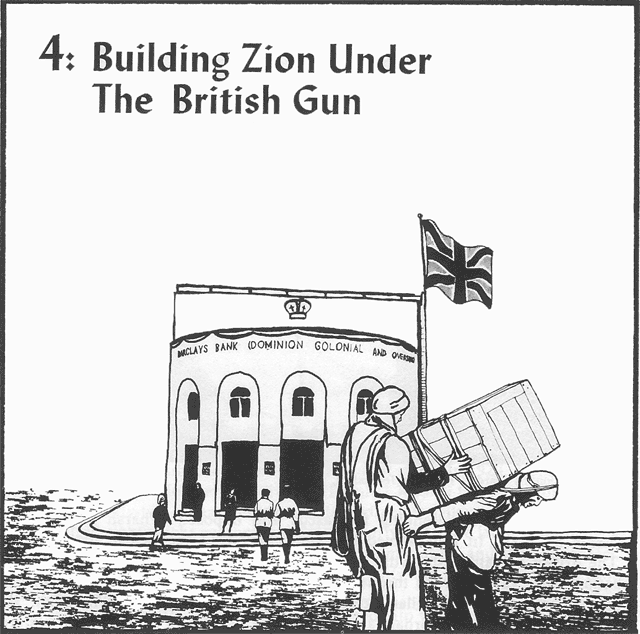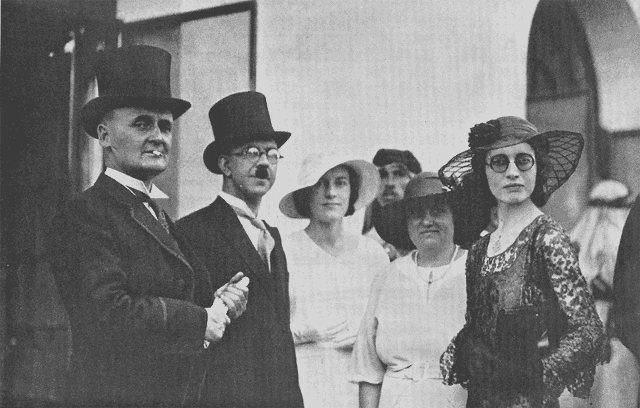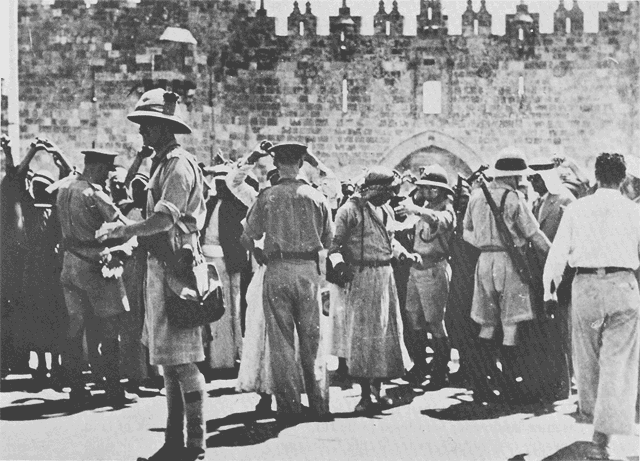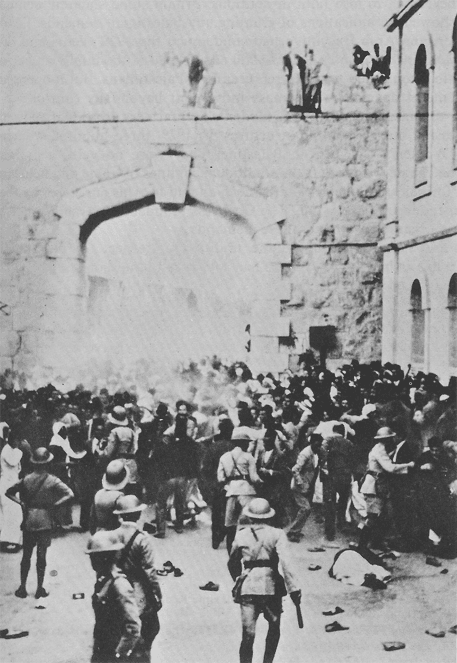Our Roots Are Still Alive - Chapter 4
Previous: Chapter 3
Table of Contents
Next: Chapter 5
New Jersey Solidarity-Activists for the Liberation of Palestine Main Site

- The advantages to the British Empire are obvious. The Suez Canal and air stations, the oil-pipe outlet in Haifa and its harbor, have become vital to our naval strategy in the Mediterranean. The security of the imperial complex of interests can be better assured by a large European population than by the few battalions that can be spared.
- British Lord Melchett
A 1920 editorial in a Palestinian newspaper predicted the bloody era of the British mandate. It said:
- Palestine is Arab - its Muslims are Arab - its Christians are Arab - and its Jewish citizens are Arab too. Palestine will never by quiet if it is separated from Syria and made a national home for Zionism.1
Arabs call 1920 Am Al Nakba, the Year of Catastrophe. Greater Syria was artificially divided into Syria, Lebanon and Palestine, and placed under French or British occupation. The occupying troops met strong resistance. French troops mowed down Syrians defending Damascus and imposed a harsh military dictatorship on Syria. In Iraq, armed rebellion challenged the British mandate.
 The British High Commissioner's Garden Party in Jerusalem
The British High Commissioner's Garden Party in Jerusalem
The British bargained shrewdly with Feisal, who fled Syria after the French occupation. They gave him the throne of Iraq in return for his acceptance of British control. They struck a similar agreement with Feisal's brother, Abdullah. He became the king of Trans-Jordan, a country which the British carved out of eastern Palestine. The feudal chiefs who had led the Arab Revolt during World War I readily accepted a sham independence.
In Palestine, Britain had different plans. It did not offer the government to the local Arab leaders. By issuing the Balfour Declaration, the powerful British Empire had committed itself to overseeing the growth of a Zionist colony on Palestinian land. Britain appointed a leading British Zionist, Sir Herbert Samuel, High Commissioner of Palestine.
"Palestine Will Never Be Quiet"
In December 1920, the Palestine Arab Congress met in Haifa. It was the first all-Palestinian political congress. The delegates discussed the grave dangers confronting the Palestinian people. Palestine faced more than another occupier. The Zionist colony threatened the national life and the individual livelihoods of all Palestinians.
Present at the Congress were members of the powerful merchant and landowning families of Palestine, along with some professionals. They feared that Zionism would undermine their position as political leaders and their economic role in Palestine. They elected a twenty-four member Arab Executive that included Christian and Moslem delegates. It began a long round of petitioning the mandate government. The three demands of the Executive remained constant throughout this period.
- An end to British support for Zionism.
- An end to Jewish immigration.
- Formation of a representative national government.
The majority of Palestinians, including peasants and working people in the cities, supported the Arab Executive and their demands in the early years of the mandate period. The month before the Congress, people demonstrated on November 2, the anniversary of the Balfour Declaration. November 2 continued to be a day of mourning for Palestinians throughout the mandate. Arab shops closed their doors, newspapers appeared with black borders, and people draped black crepe paper on their houses and flew black flags. Similar events marked December 9, the day General Allenby entered Jerusalem in 1918 - with the promise of Palestinian independence. Now he had proven to be another conqueror.
Peasants, in particular, felt their survival was at stake. In 1920, Zionists paid Sursuk, an absentee landowner who lived in Beirut, £ 300,000 for a huge block of land, including twenty-two villages, in the fertile Esdraelon valley of northern Palestine. Six hundred eighty-eight peasant families were driven off the land. Their fields were given to new Jewish immigrants. As Zionist immigration and land purchases increased, the frustration and misery of the peasants and urban poor led to protests stronger than petitions or days of mourning.
In the spring of 1921, Palestinian anger turned into violence in the city of Jaffa. A clash between two Zionist groups at a parade spilled over into the Arab quarter. Palestinians attacked a Jewish immigration center and killed thirteen Jews. Fighting spread throughout the city.
The British appointed the Haycraft Commission to investigate the 1921 "disturbances." It pointed to the source of the bloodshed: Palestinian anger at increased Zionist immigration and at the Zionist goal of a national home in Palestine.2 But Britain was not about to halt the flow of Jewish immigrants. The year before, in a British policy statement known as a White Paper, Britain had promised to set immigration quotas that would match Palestine's "economic capacity at the time to absorb new arrivals." The pledge was empty. The real guides for British policy were the needs of the British Empire and the capacity of the mandate government to control Palestine. The logic was simple. A Zionist colony would serve the British Empire better than an independent Arab Palestine. European Jewish settlers were more reliable allies than Arab nationalists. Therefore, Jewish immigration had to continue and a representative government could not be allowed. Lord Balfour put the point bluntly in a confidential memorandum of 1919:
- [I]n Palestine we do not propose even to go through the form of consulting the wishes of the present inhabitants of the country... The Four Powers are committed to Zionism...3
A young Zionist settler from America echoed British logic. Golda Meir, who was later to become prime minister of Israel, wrote in a letter in 1921:
- If we dig here, England will come to our aid. It is not the Arabs whom the English will pick to... colonize Palestine, it is we.4
Colonizing Palestine required a Jewish majority which, in turn, demanded a steady flow of immigrants. Zionism meant, as the Zionist leader Dr. Eder testified in 1921, "one National Home in Palestine, and that a Jewish one, and not equality in the partnership between Jew and Arab, but a Jewish preponderance."5
 British police constatnly harassed Palestinians
British police constatnly harassed Palestinians
There were fifty-six thousand Jews and about a million Palestinians in Palestine at the end of World War I. Between 1919 and 1923, thirty-five thousand Jewish immigrants arrived. Another thirty-five thousand arrived in 1925 alone. The number of immigrants was directly related to crises in Europe. In these years, a majority came from Poland, where economic depression and virulent anti-Semitism caused many Jews to flee their homes. In 1923, the U.S. government decided that Eastern European immigrants were too "socialistic" and it slashed the immigration quotas for Eastern Europeans. Many of those who had hoped to follow their friends and relatives to the United States could not do so. They went to Palestine instead.
Socialist Dreams - Colonial Reality
It would have been hard under the best circumstances for the economy of Palestine to absorb so many new arrivals without disrupting the economic life of the Palestinians. Zionist plans for the new immigrants made it impossible. Zionists set out to build separate Jewish factories, banks, schools, a trade union, villages, and even a port city. Tel Aviv, founded in 1903, grew up near Jaffa as an all-Jewish city that tried to draw away Jaffa's shipping and trade. When the Jewish National Fund bought Palestinian land, it bought more than farms. It bought pieces of the future Jewish state. Such actions set the Jewish colony on a collision course with Palestine.
The leaders of "Labor Zionism" were the strongest supporters of Jewish separatism. They founded the exclusively Jewish trade union, the Histadrut, in 1920. It rapidly became the spearhead of anti-Palestinian activity. The Histadrut called its program "socialist." It proclaimed that the Jewish state had to be built by the toil of Jewish workers. In lofty statements, the Histadrut insisted that Jews should not exploit native Palestinians by hiring them to work in fields or factories. Histadrut leaders coined three slogans to guide the Jewish colony: "Jewish Land, Jewish Labor, Jewish Produce." Following these slogans, Zionist agencies only leased land to Jews; Jewish agricultural settlements and industries only hired Jews; and Jews boycotted fruits and vegetables from non-Jewish farms. Thus, in the name of "socialism," Palestinians were excluded from the Jewish sector of the economy.
Jewish businesses, tempted by cheap Palestinian labor, sometimes violated the "Jewish Labor" principle. They saw no reason why industrialists in the Jewish settler colony could not profit from cheap labor as European settlers in Rhodesia and South Africa did. But the Histadrut program appealed to the large number of new settlers coming from Europe who arrived in Palestine penniless and anxious to find work. Many had been active in European socialist movements. The idealistic speeches of Zionist leaders struck a sympathetic chord among these immigrants. They agreed with the Histadrut argument that jobs and higher incomes for Jewish workers rested on the exclusion of the Palestinians. Like their leaders, the new immigrants ignored the impact of the "Jews only" policy on the Palestinians. They had brought to the shores of Palestine ideas of European "superiority" and the conviction that Jews were the historic owners of Palestine. They quickly began to treat Palestinians as their enemies.
As the Jewish colony grew during the 1920s, so did the strength of Labor Zionism and the boldness of its actions. Members of the Histadrut picketed and stood guard at Jewish orchards to prevent Arab workers from getting jobs. Squads of activists stormed through marketplaces, pouring kerosene on tomatoes grown in Arab gardens or smashing eggs that Jewish housewives might purchase from Arab merchants. The Jewish National Fund gave its agents large sums of money to buy land from rich absentee landowners or to pressure small farmers who were deeply in debt to sell their land. Zionists then evicted the peasants who lived on the newly purchased land.6
Increasingly, the leaders of the Histadrut became leaders of the Zionist movement. Three future prime ministers of Israel - David Ben-Gurion, Golda Meir and Levi Eshkol - would come from the ranks of this "trade union." The Histadrut, with each passing year, became more of a training ground for the administrators of the future Jewish state. It ran businesses, financed construction, directed the placement and growth of the agricultural settlements, and extended its influence over many aspects of its members' lives.
Among Jewish organizations in Palestine, only the small Palestine Communist Party pointed to the reality behind the myth of Zionist "socialism":
- The party must explain to the masses of Jewish workers that the Zionist bourgeoisie (businessmen, trade union officials, etc.) exploited their situation as victims of persecution in Eastern Europe and turned them into an instrument to oppress and dominate the masses of Arab workers.7
But the Communists remained a minority voice. Most Zionists proudly showed visitors from Europe and America the Zionist agricultural commune, called a kibbutz, and praised its spirit of equality and hard work. They impressed visitors with its cooperative decision-making, daycare centers, and well-irrigated fields. Hidden was the fact that each kibbutz was also a small military base of the Haganah, the Jewish Army founded in 1923. The "equality" of the kibbutz was for Jews only. A kibbutz often needed military protection because it stood on land farmed by Palestinians for generations.8
1929 Uprising: A Turning Point
By 1929, Zionist settlement had driven almost two thousand Palestinian families off the land. Sometimes these peasants found work tenant-farming, or they became laborers in small Arab factories. But often they remained unemployed. The growing Jewish sector was closed to them. Wage differences between Palestinian and Jew increased each year: in 1929 the average Jewish worker made nine times the wages of a Palestinian. The economy of the Zionist colony was capitalist. As that economy expanded, the traditional economy of Palestine became shakier.
The Zionist colony expanded rapidly. International donations supplied the capital to open new businesses and buy more land. Zionist fundraising got a boost with the creation of the Jewish Agency in 1928, a world-wide umbrella organization that raised money for Zionism. In addition, the British showered favors on the Zionists, granting them 90 percent of all economic assistance from the mandate government.9 The British were deaf to Palestinian requests for such things as a bank to give low-interest loans to Palestinian farmers or a plan to build credit cooperatives to boost the Palestinian economy. Zionists were granted all the major concessions for the economic development of Palestine. They received a monopoly on the use of the Jordan river water for electricity and irrigation. Under these concessions, Zionist businesses extracted salt from the Dead Sea and constructed new ports.
Zionists in Palestine also mounted an offensive to get more political power. On August 15, 1929, Zionist settlers from outlying areas poured into Jerusalem to demonstrate at the Wailing Wall. The Wall was sacred to the Jews as part of the ancient Temple of the Second Kingdom and sacred to Moslems as part of the Dome of the Rock, one of the three holiest shrines in the Islamic religion. It was the practice of Zionists to turn the symbols of Judaism, like the Star of David, into emblems of the Zionist movement. To Palestinians, these emblems became symbols of conquest. At the Wall, the settlers raised the Zionist national flag and sang the Zionist national anthem, acts calculated to provoke Palestinian anger. During the demonstration, members of a right-wing Zionist group passed out pamphlets that advocated an armed takeover of Palestine. The next day, Palestinians held a counter-demonstration. Word spread to the countryside that the Moslem shrine was in danger. On August 23, peasants streamed into Jerusalem, and a riot broke out. Rioting spread from the city to surrounding towns. British troops were called in. When the fighting was over, 133 Jews and 116 Palestinian Arabs were dead. Most of the Palestinians were killed by British soldiers.

1929 rebellion suppressed by British soldiers.
The British issued another report, citing the familiar causes of the violence. The Arab Executive presented the usual petitions for a representative government. But the people were beginning to lose faith in petitions. Britain stood squarely behind the Zionists and showed no indications of granting any Palestinian demands. Fearful of confrontation, the Arab Executive had condemned the 1929 events and ordered the peasants to retreat. The Executive, still at the head of the family and clan structure of Palestine, continued to try to represent the Palestinians. But it opposed any activity that might develop into a mass movement beyond its control.
After 1919 new organizations of women, students and farmers arose that allowed for political expression outside the old structures. In 1929, three hundred women participated in a Women's Congress in Palestine. They wore no veils, a radical gesture for the time. These women left the traditional confines of home and fields to demand freedom for Palestinian political prisoners, an end to arms purchases by the Zionists and independence for Palestine. The Congress founded the Arab Women's Union to continue organizing around these demands.
Angry writers and intellectuals broke the tradition of respect for prominent families, and began to aim barbs at those who had sold land to the Zionists. The poet Ibrahim Toquan launched a sharp attack:
- They have sold the country to their enemies because of their greed for money; but it is their homes they have sold. They could have been forgiven if they had been forced to do so by hunger, but God knows that they have never felt hunger or thirst.10
The uprising of 1929 marked a shift in the Palestinian resistance to Zionism. Many Palestinians were becoming increasingly impatient with the Arab Executive's do-nothing policy. They realized that it would take more militant and sustained action to free their country from both Zionism and British occupation.
Footnotes
- Al-Nafa'is, cited by Ghassan Kanafani, "The 1936-39 Revolt in Palestine: Background, Details and Analysis," PFLP Bulletin (January-February 1975), p. 7.
- Robert John and Sami Hadawi, The Palestine Diary, 2 vols. (New York: 1970), 1:176.
- Memorandum by Lord Balfour, 19 September 1919 (FO:371/4183/2117/132187), cited by William B. Quandt, The Politics of Palestinian Nationalism (Berkeley: 1973), p. 9.
- Marie Syrkin, Golda Meir (Paris: 1966), p. 63, cited by Maxime Rodinson, Israel: A Colonial-Settler State? (New York: 1973), p. 106.
- William B. Ziff, The Rape of Palestine (New York: 1938), p. 171, cited by John and Hadawi, 1:176.
- Cited by Bober, ed, The Other Israel, p. 12.
- Cited in "The Left in Israel," MERIP no. 49, p. 8.
- Amos Perlmutter, The military and Politics in Israel (New York: 1969), p. 32.
- Nathan Weinstock, Le Sionism - Contre Israel (Paris: 1968), cited by Kanafani, PFLP Bulletin (September-October 1974), p. 7.
- Cited by Kanafani, PFLP Bulletin (January-February 1975), p. 7.